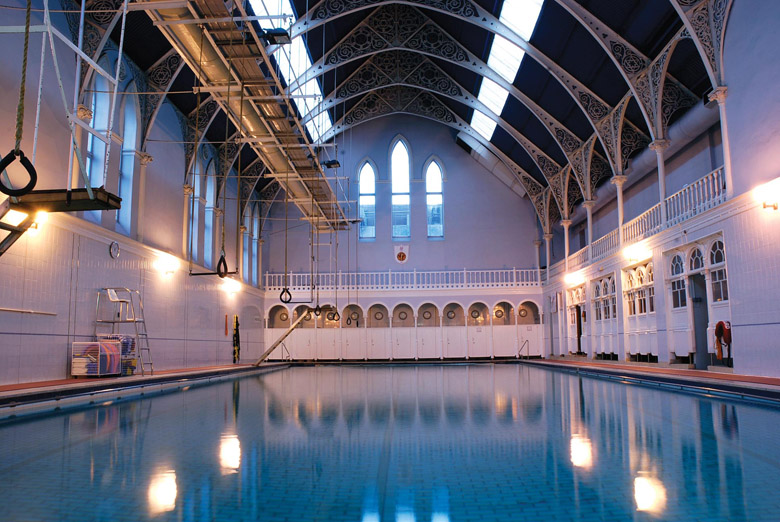
30 Aug The History of Traveling Rings in Scotland
The traveling rings have been around for quite some time despite the common perception of being a new apparatus. Mentions of the traveling rings date back to as early as the 1870s and were quite popular in the early 1900s as a form of exercise and physical therapy. Scotland has a long history involving the traveling rings (or “travelling rings” as they are spelled in the UK), so it is of no surprise that there are still some in existence. Why does Scotland have so many sets of traveling rings and where can they be found?
Arlington Baths Club (Glasgow, Scotland)
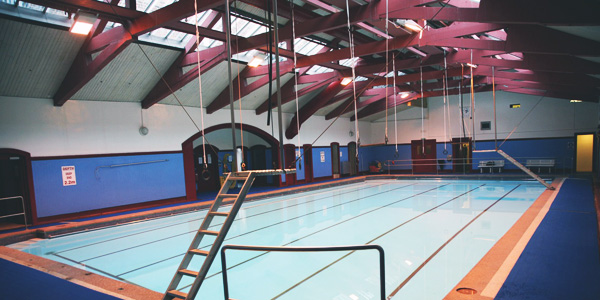
The Arlington Baths Club was originally built during 1870 – 1871 using Victorian-style architectural elements reflecting the trends of the time. The original building was designed by architect John Burnet, the father of Sir John James Burnet.[1] It opened its doors on the 1st of August, 1871 as the Arlington Swimming Club.[2] The Arlington was the first of the Victorian swimming clubs, certainly in Glasgow, and perhaps in the United Kingdom. A replica of Arlington Baths was built soon after in London but was bombed during the Second World War and was never rebuilt. The building of the Arlington Baths coincided with the implementation of the first of the Public Health acts in 1870 and was considered by some to be the precursor to the growth of public bathing in the UK.
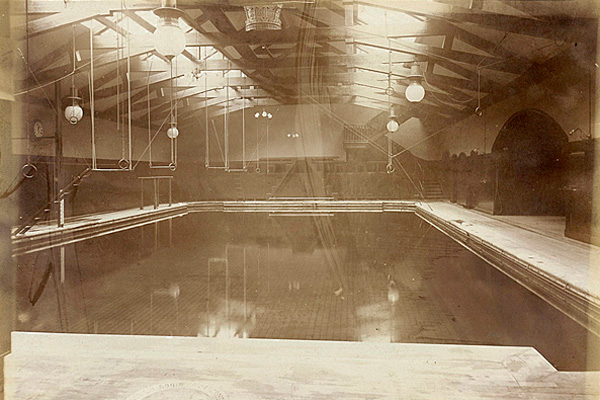
Photograph of the swimming pool at the Arlington Baths circa 1900.
The traveling rings have a long tradition at the Arlington Baths Club. A series of 7 rings were hung from ceiling beams over the swimming pool so that club members could “travel” from one end of the pool to the other. Alongside the rings are a pair of flying trapeze bars.
Video of modern day ring swinging at the Arlington Baths Club:
More information on the Arlington Baths Club:
Current status: Open
Website: www.arlingtonbaths.co.uk
Address: 61 Arlington Street, Glasgow G3 6DT (google street view)
The Western Baths Club (Glasgow, Scotland)
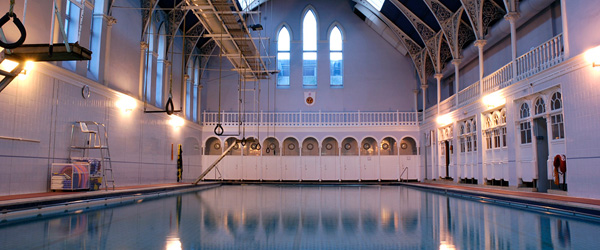
Shortly after the opening of the Arlington Baths another baths club was erected in Glasgow – The Western Baths Club. Designed by local architects Clarke & Bell, the Western Baths Club opened its doors in 1876 as a gentlemen-only club. Many of the original members, who tended to be wealthy local men, would arrive in the early morning by horse and carriage for breakfast and a swim. It is said that the men could even indulge in a shave courtesy of an on-site barber before departing back to their mansions. By the early 1900s women were using the facilities as well and even competing in swimming competitions.[3]
Video of Kris Goodman performing flying trapeze and traveling rings swinging at the Western Baths:
According to the current administrators of the Baths the traveling rings and trapeze were installed over the pool in 1878. It must be an exhilarating experience to swing on rings with such history.
More information on the Western Baths Club:
Current status: Open
Website: www.thewesternbaths.co.uk
Address: 12 Cranworth Street, Glasgow, Scotland, G12 8BZ (google street view)
Drumsheugh Baths Club (Edinburgh, Scotland)
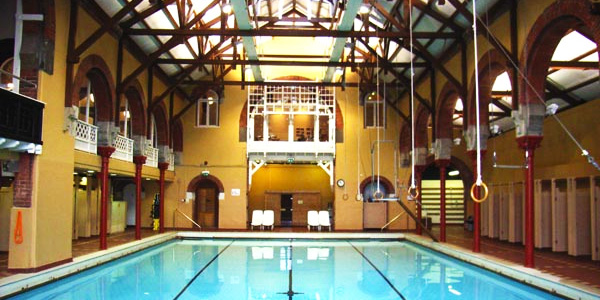
In the Scottish capital of Edinburgh lies another bathhouse, called the Drumsheugh Baths Club, which contains a set of traveling rings over a swimming pool. This baths club was built by Sir John James Burnet (whose father designed the Arlington Baths) and opened in 1882. This baths club was designed in the Moorish style, perhaps influenced by Turkish baths Burnet had seen in Paris during his training. Ten years after its opening the building was completely destroyed in a fire, only to be rebuilt by Burnet, Son and Campbell.[4]
More information on the Drumsheugh Baths Club:
Current status: Open
Website: www.drumsheughbaths.com
Address: 5 Belford Road, Edinburgh EH4 3BL (google street view)
Public Baths & Gymnasium at Primrose street (Alloa, Scotland)
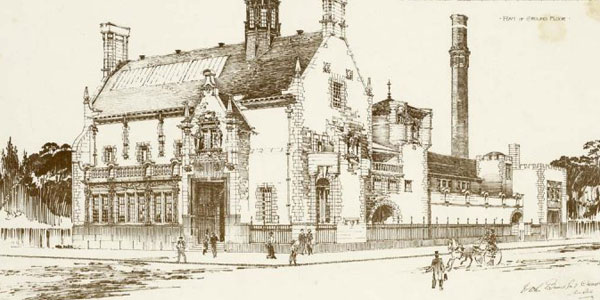
Illustration of the original building as it stood in 1897.
The Public Baths and Gymnasium at Primrose street was a highly sophisticated building with complex articulated circulation areas connecting the various sections. The building was commissioned and gifted to the town of Alloa by Thomas Paton, and designed by Sir John James Burnet and John Archibold Campbell from 1895-98.[5] In contrast to other bathhouses of the time, this one was built with the intention of providing access to the working class. Best of all, the building contained not one but two sets of traveling rings!
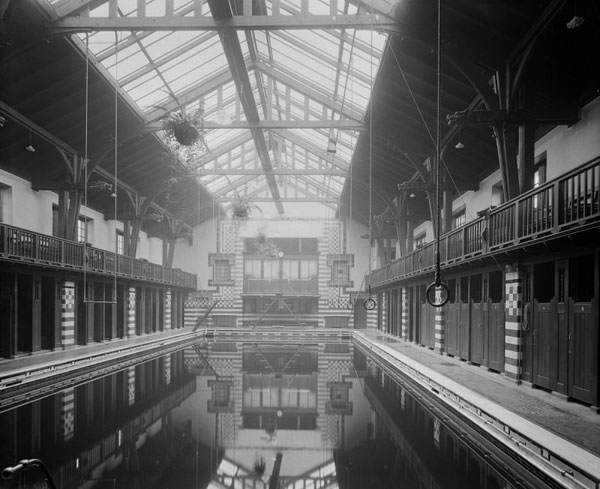
The swimming pool with flying trapeze and traveling rings (1898).
The swimming pool atrium contained changing stalls on the first storey with balconies above so that one could relax and observe the activities. A series of four, or possibly five, traveling rings could be seen hanging from the ceiling above the swimming pool, complemented by the adjacent set of flying trapeze bars.
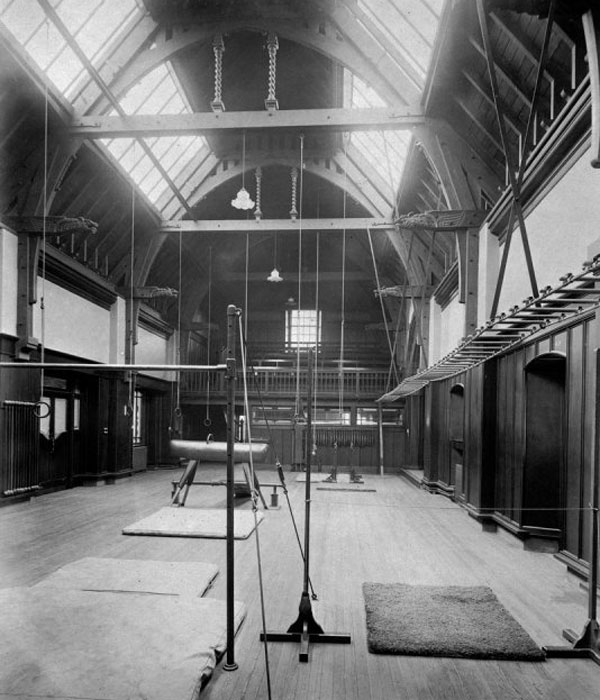
Gymnasium containing horizontal ladder, traveling rings, pommel horse, bars and other apparatuses (1898).
The building later fell into disuse, was renamed Speirs Centre and was converted into a gymnastics facility that housed four separate gymnastics clubs, including one for disabled children. In 2011 the building became home to the Clackmannanshire Museum service and the gymnastics clubs were forced to move elsewhere. The swimming atrium has been converted into a public library which, unfortunately, means that there will be no more swinging on the rings.
More information on the Public Baths & Gymnasium at Primrose street:
Current status: Closed (converted for other use)
Address: 29 Primrose Street, Alloa FK10 1JJ (google street view)
Badaguish (near Aviemore in the Cairngorms National Park, Scotland)
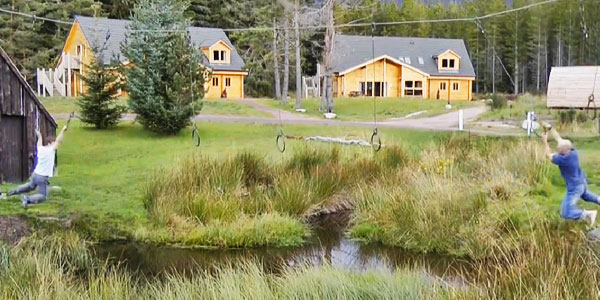
Visitors of the Badaguish Outdoor Centre will notice a strange apparatus hanging above the river by the holiday complex – a set of traveling rings! These rings are suspended by steel cables which are connected to a steel horizontal cable that spans the width of the river. Kids and adults alike seem to love these “hanging hoops” but nobody enjoys falling in the brisk water.
Video of a man swinging on the Badaguish rings:
Records indicate that Badaguish was founded in 1984 so it is possible that the person who conceived of these rings had grown up using one of the sets in a bathhouse. These rings look like loads of fun, albeit quite difficult to swing on due to the wobble of the cables.
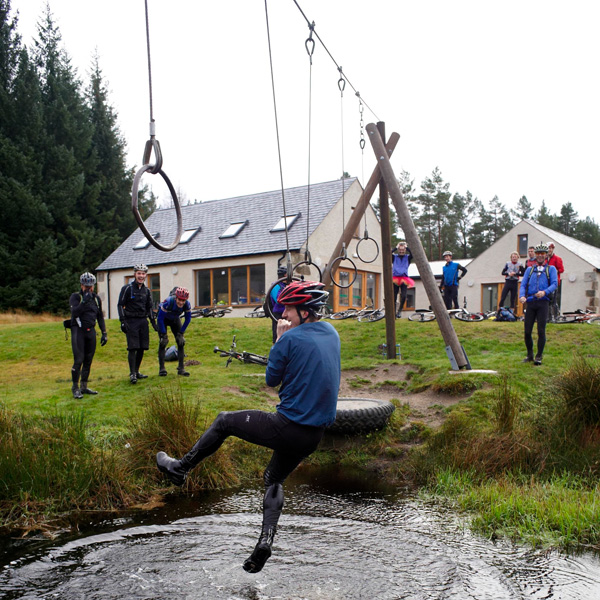
Cyclist Bruce Duncan swinging on the Badaguish rings.
More information on the Badaguish Outdoor Centre:
Current status: Open
Website: www.badaguish.org
Address: Aviemore, Inverness-shire PH22 1QU
Why were traveling rings installed in bathhouses and gyms in Victorian Scotland?
The simple answer is they were a great form of exercise and, most of all, fun. How they came to be installed in Scotland is still a mystery but perhaps the origin of modern gymnastics rings can shed some light on this matter.
The “father of modern gymnastics” Friedrich Ludwig Jahn had developed gymnastics in the early 19th Century in Germany. Although Jahn did not incorporate use of rings into his repertoire, one of his students, Adolf Spiess, invented an apparatus that he referred to as ringeschwebel in 1842.[6] The ringeschwebel, as described in his Turnlehre, or “gymnastics lesson,” consisted of two hanging triangular grips which one could hang from to swing back and forth (similar to modern “flying rings”). Later circular rings replaced the original triangular grips.
John Burnet sent his eldest son, John James Burnet to study Architecture at the École des Beaux-Arts in Paris while his other son, George, studied in Heidelberg, Germany. Burnet is known to have traveled and sketched in Germany, France and Italy but dates are lacking.[7]
Perhaps Burnet encountered one of the early German gymnasiums during his travels and took a liking to the idea of rings being used for physical training and later combined that with his desire to build Turkish baths. It may be a stretch of the imagination but records from that era are scant and we may never know whose idea it was to build traveling rings in Scotland. Thankfully a few sets of traveling rings remain in Scotland and are still being enjoyed to this day.
- http://en.wikipedia.org/wiki/John_Burnet_%28architect%29 ^
- http://hsewsf.sedsh.gov.uk/hslive/hsstart?P_HBNUM=32173 ^
- The Glasgow Herald – Jun 4, 1988 ^
- Great Lengths – http://www.playedinbritain.co.uk/books/great-lengths.php ^
- http://canmore.rcahms.gov.uk/en/site/120060/ ^
- http://www128.pair.com/r3d4k7/Climbing&Gymnastics2.0.html ^
- http://www.scottisharchitects.org.uk/architect_full.php?id=100033 ^



